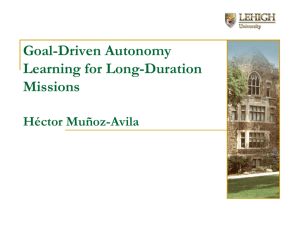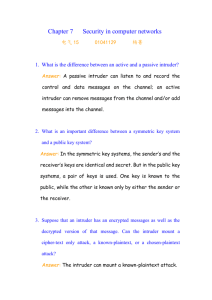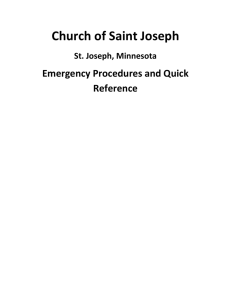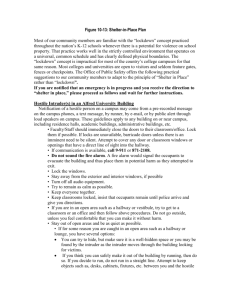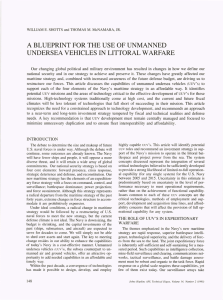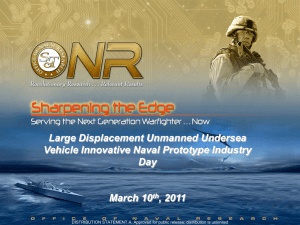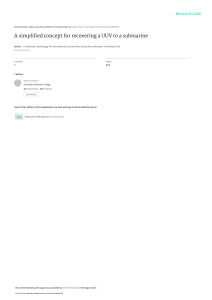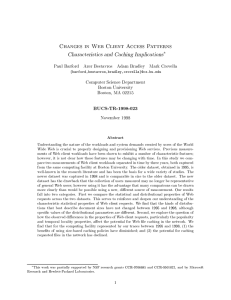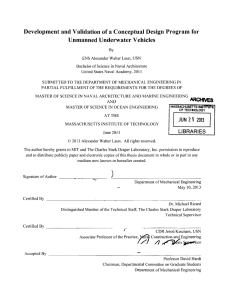Goal-Driven Autonomy & Robust Architectures for Long
advertisement
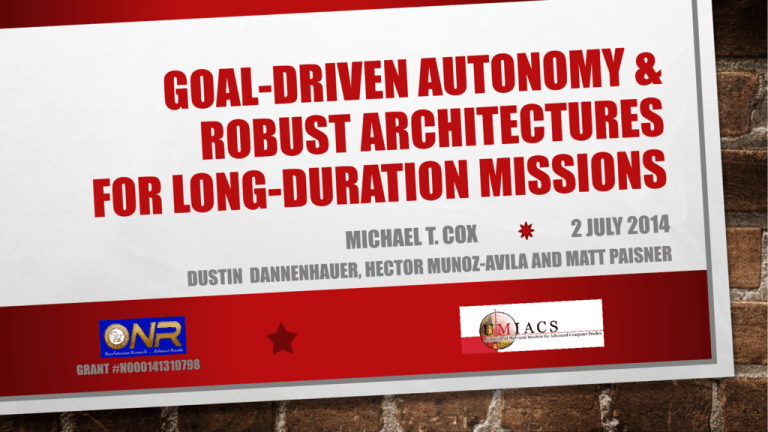
THE PROBLEM OF LONG-DURATION AUTONOMY • One cannot foresee problems and opportunities in advance • Humans cannot continuously monitor the state of affairs looking for unexpected problems and opportunities • Instead the system must be robust in the face of surprise 2 VISION AND APPROACH Overall Objectives: • To articulate a foundation for long-duration autonomy that integrates the MIDCA and T-REX architectures • To formulate learning techniques that ensure robustness by adapting to uncertain and changing environments • To provide a prototype implementation that exhibits this integration on actual physical platforms Approach: Metareasoning combined with Goal-Driven Autonomy • Allows agent to see contradictions/anomalies and remedies to current plans and actions • Can be applied, for instance, to shipboard firefighting where new fires may break out 3 GOAL-DRIVEN AUTONOMY (GDA) • RECOGNIZE NOVEL PROBLEM (OR OPPORTUNITY) • EXPLAIN WHAT CAUSES THE PROBLEM • GENERATE A GOAL TO REMOVE THE PROBLEM (OR TO LEVERAGE THE OPPORTUNITY) 4 THE GDA MODEL 5 METAREASONING Action Selection Ground Level Meta-level Control Object Level Perception Meta-Level Introspective Monitoring Doing Reasoning Metareasoning UUV TREX MIDCA 6 T-REX AGENT USED ON THE DORADO UUV • Goal-centric agent control • Partitioned problem-solving with continuous, parallel decision and control loops • Reactors encapsulate control loops and share state variables 7 REACTOR PARAMETERS • Planning look-ahead ϑ The expected number of ticks into the future for which the reactor will plan • Planning latency λ The expected time a reactor will take to produce a plan and to integrate new goals 𝑃𝑤 = τ + λ, τ + λ + ϑ 8 METACOGNITIVE INTEGRATED DUAL-CYCLE ARCHITECTURE Goal Management goal change goal insertion subgoal goal input goal change Metagoal Goals insertion subgoal Intend Meta Goals Reasoning Trace ( ) Plan Intend Meta-Level Control Strategies Mental Domain = Ω ) Intend Problem Solving Task Plan Actions = Ω Mental Domain Act (& Speak) Interpret Introspective Monitoring goal Trace insertion Goals MΨ Monitor MΨ Evaluate Memory Mission & Goals( ) World Model (MΨ) Comprehension Hypotheses MΨ Interpret Episodic Memory Semantic Memory & Ontology Plans( ) & Percepts ( ) World =Ψ 9 Monitor goal input subgoal Metaknowledge Self Model ( ) Hypotheses Episodic Memorygoal change Introspective Monitoring Evaluate Trace Metaknowledge Self Model ( Controller Reasoning Trace ( ) Controller Interpret Episodic Memory Memory Activations Hypotheses Strategies Activations Task Evaluate Memory Task Plan Meta-Level Control goal input Percepts Perceive (& Listen) MODEL OF SELF-REGULATED PERFORMANCE Task & goal ( confusion or uncertainty Trace ( ) cost & benefits goal insertion Causal Attribut. (Assess) Anomaly Detect (JOL) ) int or ext? Strategy Decision choice & reasons internal MΨ external L Models Strategy Execution (Guide) ignore anomaly ∆ A World (Ψ) = learning goal A = attainment goal = self model L 10 MIDCA’S MODEL OF TREX (MΩ) • A hierarchical graph of agent reactors and their connections • For each reactor • Internal and external variables • Values for parameters (e.g., λ and ϑ) • Current reactor state (e.g., failed) • Representations of traces of TREX run-time behavior • Control structure: Goal and parameter manipulation 11 THE MIDCA RESPONSE • Reducing the window size of Reactor2 constrains the planning for goals internal to it 12 EXAMPLE UUV MISSION COMMANDER’S INTENT: END-STATE: QROUTE IS SAFE TASKS: CLEAR MINES IN GA1 AND GA2 • • UUV-2, AN UNMANNED UNDERWATER VEHICLE, IS ASSIGNED A MISSION REGARDING THE GREEN AREA PORTION OF A HARBOR DURING ITS TRANSITS, UUV-2 PASSES UNEXPECTED OBJECTS OF INTEREST 13 PROBLEM RECOGNITION UUV 2 Tasks: Clear mines in Green Sub-areas GA1 & GA2 New State RECOGNIZE Actual Observed State Previous States Compare States Expected State World Model Discrepancy Transit Problem Data PROBLEM EXPLANATION EXPLAIN Exp1 Transit Route Problem: • Exists mine between Sub-areas • Mine should have been seen during recon • Mine threatens mission Exp2 Near IsIsNear QRoute Ship Action: Action: Intruder Intruder Damages Lays Ship Mine Knows Knows about about Target Target Can See After Ship Friendly Activity Recon Action: Action: Intruder Intrudermoves moves using Vessel using Vessel Exp3 Expn Select Explanation Explanation 3: Intruder Explanation Laid New Minefield GOAL MANAGEMENT MANAGE GOALS Actions DG Goal Management can: • • • • • Create goals Abandon goals Transform goals Prioritize goals Assign resources Explanation 3: Intruder Laid New Minefield Search for Intruder 7h94 Search for all Intruders Search for all Intruders Clear Mines in Green Sub-areas Clear Mines in QRoute Generate & Change Goals • Survey QRoute in serpentine patterns • Maintain lane distances of 0.2 nM for survey • Establish communications • Transmit obstacle sighting location to Fleet HQ using frequency Bravo • Use default MCM sweep pattern to clear Minefield beginning at coordinates (x,y) AI Planner Goals Resources Report Obstacle Report Obstacle EVALUATION SANDBOX System-wide Evaluation: • Assign points and penalties to mission activities in Sandbox • Compare GDA mission performance to 3 control conditions: ◦ Optimal, Conventional, & Random action UUV • Metrics: Percentage of points scored on objectives over time as problem complexity and amount of resources vary • Software implementation for testing purposes • Provides “discovery course” with various missionrelated objects and events linked to actual platforms and sensors Optimal 100% GDA UUV Conventional UUV Consistently higher performance Performance degrades smoothly Performance degrades rapidly Cannot adapt to loss of resources Conventional UUV Random Chance 100 100 Mission Performance GDA UUV Mission Performance (% of max) 80 80 Mission Performance 60 40 30 Time 60 40 Performance will be bracketed by the ideal score and random score for fair comparisons 30 20 Resources 10 0 2 4 6 8 10 Complexity 20 Resources 10 0 2 4 6 8 10 Complexity 17 CONCLUSION • The problem of long-duration autonomy is the inability to foresee all problems and opportunities • The solution involves problem recognition, goal generation, and metareasoning • The project contains both challenging problems and significant opportunities, not all of which we can foresee 18
